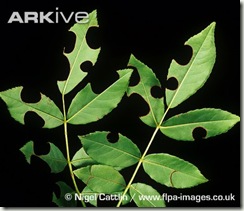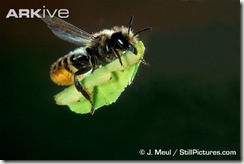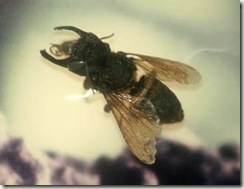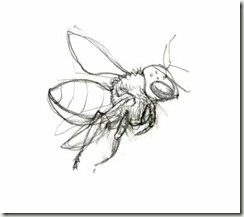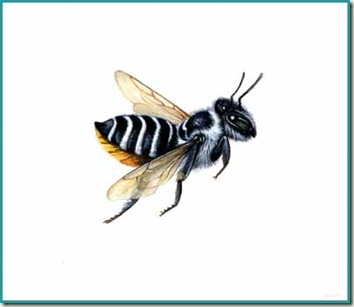If you happen to notice some beautifully cut, circular holes in your rose leaves you may well have some Megachile bees in your garden.
There will be no great damage to your plants and what some may find unsightly, I think is rather attractive.
Also, when you know that the female Megachile is just using the leaves to wrap her little ones in, you would hardly begrudge her a leaf or two, would you?
To help her this little bee is equipped with very strong chewing mandibles which she uses to bite through the leaves. It only takes one or two seconds for her to complete this operation.
Here is a sequence of photos by different photgraphers from the excellent photographic site Arkive: Images of Life on Earth, and the text is from “Bees of the World” by Christopher O’Toole and Anthony Raw.
“Just before the leaf fragment becomes completely detached the female vibrates her wings rapidly so she is already in flight as soon as the leaf is free.
She then flies a short distance and lands on the ground, a stone or a tree trunk while she adjusts her load. If the leaf fragment is longer than broad she uses her feet to fold it lengthways, so she straddles the leaf with its convex surface towards her. She flies back to the nest carrying the leaf in this way.”
There she makes beautifully crafted overlapping nest pockets, a kind of natural origami pot with which she lines her nest.
“She sticks the leaf fragment together by crimping the edges of the leaves so that sap oozes out and this possibly with salivary glue acts as an adhesive.”
I am fascinated by the shape. These individual cells must fit into each other so the bee must know to taper them.
Here is a very nice description from an article by Louise Kulzer from the website;
“Bugs of the Month” by Scarabs: The Bug Society, here
Actually, it’s a bit more elaborate than just lining the nest burrow. Leaf-cutter bees construct several cells from the leaf pieces they collect. The cells are positioned end to end in a long burrow.
Several circular leaf pieces form the bottom, then oblong pieces are placed along the sides to form a “thimble.” This thimble is then provisioned with nectar and pollen, and an egg is laid in it.Then the bee cuts more circular pieces to close the cell. Once the cell is closed, the bee starts another cell above the first, until the whole cavity is filled. Like all solitary bees, the female leaves the nest after it is closed. The grubs fend for themselves on the nectar and pollen.
The adult leaf-cutter bee is smaller than a honey bee, dark, often hairy, with a prominent pollen basket below. Females are workaholics, and are a delight to watch because, being so intent on cutting leaves, they usually ignore a nearby observer!
The leaf sections are cut with the mandibles, and the bee forms an arc with her head along the leaf edge to make the circular shape. (They remind me a little of an electric can opener, only with much more personality.)
The facts
CLASS: Insecta
ORDER: Hymenoptera, Bees, wasps, ants and sawflies.
SUPERFAMILY: Apoidea. Bees and some wasps.
FAMILY: Megachilidae
GENUS: Megachile
The Megachilae are a huge genus of bee with well over 500 species. The most important North America species is the Alfalfa leafcutter bee Megachile rotundata which is used for alfalfa pollination.
A monster member of this family is Megachile pluto. A female can reach 1.5 inches long.
photo by Stavenn from Wikipedia here.
My bee is Megachile brevis a delightfully smart and perky little bee. The body shape is unusual in that there is a definite upward tilt rather than the more downward curved body shape of other bees.
These bees, like all of the female Megachile species carry dry pollen under their abdomen in the stiff bristly hairs called the “scopa” which in other bees is located on the legs.
I have Sam Droege and Anna to thank again for their help.
There was only one way I wanted to draw this bee. She had to show her stripes and pointed abdomen and the pollen basket, so a side view to show the tilted body shape too.
A friend of mine described her yesterday as “very sassy”!
______________________________________________________________
Bee number 15: The Leafcutter Bee, Megachile brevis
Watercolour on Arches HP, Image size 3.5 inches.

